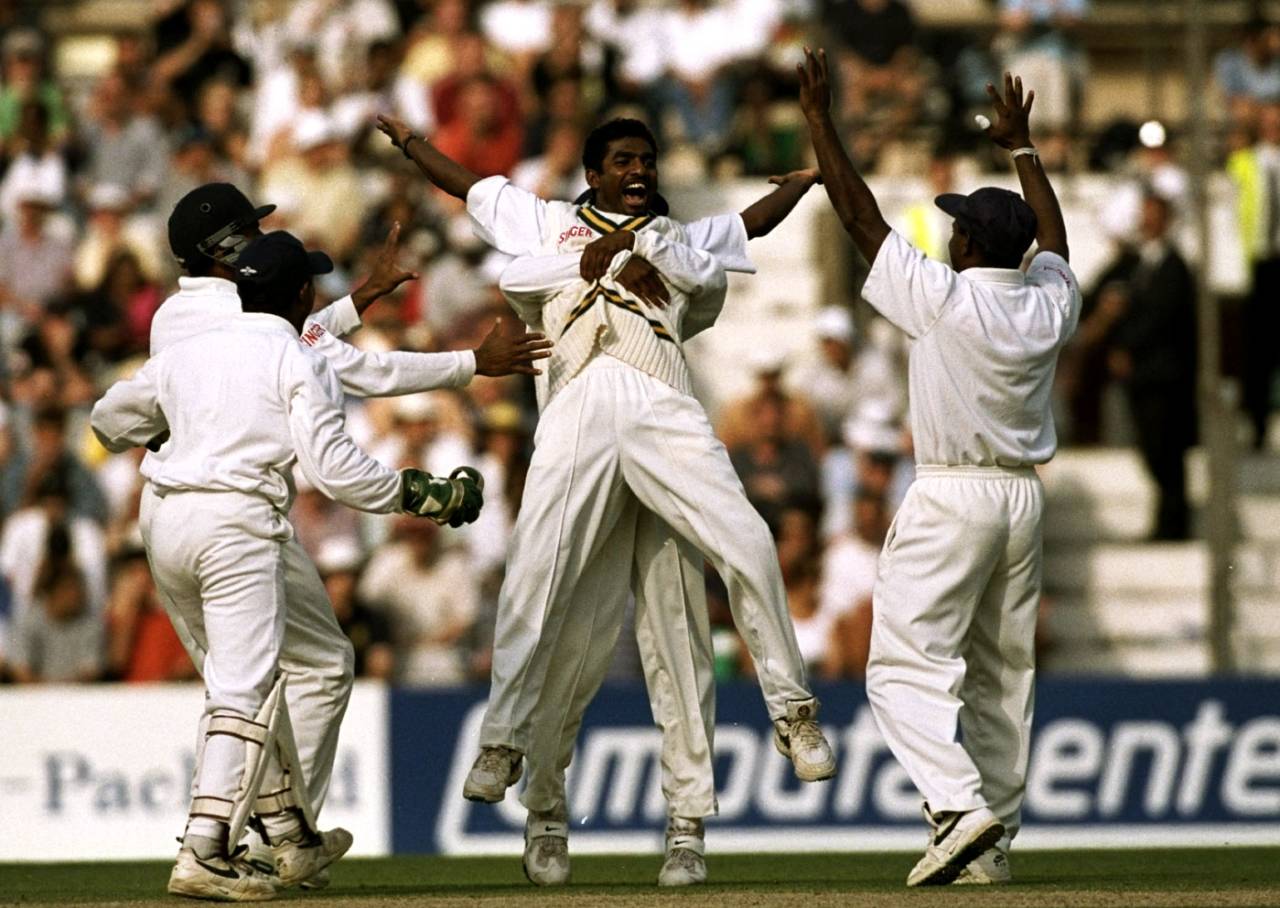Murali magic at The Oval
He could spin it on the M4, they said. Come the Oval Test in 1998, he proved them right
Janaka Malwatta
05-Jan-2014

The fifth-best match figures in history • Getty Images
The Test at The Oval in August 1998 was a defining match in Sri Lanka's development, their first Test victory over England away from home. Sri Lanka had by then proved themselves to be a cricketing nation of note. Two years previously, they had won the World Cup with a daring and fearless brand of cricket, besting the legendary Australian side in the final. Despite this, the ECB deigned to award Sri Lanka just a solitary Test. This travesty persisted until 2002, a full 20 years after Sri Lanka's Test debut. The injustice was felt keenly by the team and supporters alike. Everyone felt they had a point to prove.
Key to Sri Lanka's hopes was Muttiah Muralitharan, rapidly establishing himself as one of the world's most feared bowlers. Sri Lanka, and particularly Murali, had endured a bruising coming-of-age tour to Australia in 1995-96. Amid the controversy about Murali's bowling action, one thing was clear: Sri Lanka had progressed from innocent amateurs to serious competitors, evidenced by the sledging heaped on them by the Australians. The controversy followed Murali to England, stoked by injudicious words from David Lloyd, the England cricket manager. Curiously, Lloyd didn't seem to have the same concerns about Murali's action when Murali was harvesting wickets for Lloyd's beloved Lancashire.
In 1998, The Oval was the antithesis of Lord's. Situated among the gas rings and council estates of South London, rather than the leafy lanes of St John's Wood, The Oval was vibrant where Lord's was staid, welcoming where Lord's was aloof. Nowhere was London's north-south divide better illustrated. Crucially for Sri Lanka, The Oval pitch provided bounce as well as turn, critical to Murali's success. Asked whether Murali would be able to extract turn from The Oval pitch, Ranjit Fernando, the Sri Lanka tour manager, replied, "He would turn it on the M4." Prophetic words.
Murali was the shining light in what was arguably Sri Lanka's best Test team. Arjuna Ranatunga, shrewd and belligerent in equal measure, captained a team that also contained Sanath Jayasuriya, Marvan Atapattu, a young Mahela Jayawardene, and, the supreme batsman in a team packed with batting talent, Aravinda de Silva.
Arjuna won the toss, and put England in. To armchair critics, this was an act of betrayal. We howled in outrage. Putting the opposition in on the first day of a Test is tantamount to admitting defeat before you start. It's as clear a signal of lack of confidence and ceding the initiative as you could make. Ask Nasser Hussain.
Arjuna, ever the calculating general, had his reasons. If Sri Lanka had batted first, he later explained, his prime weapon, Murali, would tire and be less effective when Arjuna enforced the inevitable follow-on. It was the most brazen of strategies. How foolish we were to doubt him.
If Jayasuriya was the bludgeon, Aravinda was the rapier, an artist on the cricket field, an aesthete's delight
England duly proceeded to amass 445 in their first innings, courtesy of a rare Graeme Hick Test century and 154 from John Crawley. Almost unnoticed, Murali picked up seven wickets, a remarkable first-innings return for a spinner, especially outside the subcontinent in the era of covered wickets.
Jayasuriya proved he could open in both forms of the game, hitting a glorious double-century. If Jayasuriya was the bludgeon, Aravinda was the rapier to trump all rapiers, an artist on the cricket field, an aesthete's delight. Three years earlier he had enjoyed a successful summer with Kent, notching up over 1000 runs, culminating in a blockbusting 112 from 94 deliveries in the Benson & Hedges final. At The Oval, Aravinda conjured a magical 152. The combined effort gave Sri Lanka a lead of almost 150 runs. England's second innings was, from a Sri Lankan perspective, the stuff of childhood dreams. Murali's wrist flicked and flipped as he flummoxed batsmen.
His rather unexpected success posed me something of a dilemma, though. I was spending the weekend in Essex, visiting my girlfriend's parents for the first time, an important milestone in any relationship. An hour and a half away, in South London, Murali and Sri Lanka were edging towards history. I'd like to say there was a process of agonised soul-searching, a tortured battle between duty and pleasure. There was, of course, no contest. I made hurried excuses and drove south as fast as I could.
I was rewarded as soon as I arrived. I recall Ben Hollioake haplessly trapped leg-before by a flipper, first ball after tea. Murali was truly a magician that day. He picked up nine second-innings wickets, prevented from taking all ten wickets only by Upul Chandana's rather inconsiderate run-out of Alec Stewart. His 16-wicket haul is still the fifth-best bowling analysis in the history of Test cricket.
Sri Lanka were left with a target of 36 to win the match. Jayasuriya set about the task with his hallmark violence. He hit two sixes in accumulating 24 in the fourth innings. One of them was a shot of breathtaking destructiveness, a cut over point for six, hit with both feet off the ground. The end result was a ten-wicket thrashing of England on English soil. Point proved, in spades.
Janaka Malwatta is a poet, doctor and cricket lover who lives in Brisbane. He tweets here